 |
Bridge of Dreams
16x12 oil panel by Michael Chesley Johnson |
We're about halfway through the
2016 12th Annual Sedona Plein Air Festival. Artists have been enjoying a period of beautiful weather, marred only by an occasional gust of wind and, on one morning, smoke from a controlled burn near Flagstaff. It's been a great week so far, and I've enjoyed meeting the new artists and reconnecting with old friends. For me, this is my ninth time as an invited artist. (Follow the event on
my Facebook studio page and on the
festival's page.)
This year, I wanted to shake up my process. Normally for an event, I stick with the tried-and-true, but I yearned to add something new to the mix. (Remember, this is my ninth year!) So, I am starting my paintings in a new way. I'm using nothing but rich, raw color in my underpaintings and shooting for as much contrast as possible. Rather than try to mix exactly what I see, I'm just applying color straight from the tube. If I see something in shadow, I paint it either cool red, blue or cool green. If I see something in sunlight, I paint it either yellow, orange or warm red.*
 |
This Was Once an Ancient Sea
12x24 oil/panel by Michael Chesley Johnson |
And then I dull the heck out of it. I start with what area looks the most garish and grey it down first, and go from there. But always some of that rich beginning pops through. Yesterday, another artist, known for vivid color and not familiar with me or my work, stopped by my easel to say, "I'm glad there's another artist here who likes strong color!" If she'd seen me painting a week ago, she'd have expressed a different sentiment. Although the start is somewhat scary – "How am I going to pull myself out of this particular hole?" – I'm really loving this new look.
 |
Out of the Shadows
9x12 oil/panel by Michael Chesley Johnson |
By the way, this week I'm also playing with two colors from
Gamblin I haven't used before: Radiant Turquoise and Brown-Pink. The Turquoise, either pure or modified with ultramarine blue and sometimes the Brown-Pink, is great for skies. The Brown-Pink is great for drawing my initial shapes, since some of that shows through at the end and livens up the painting, and also for greying down my phthalo emerald. Thank you,
Lori Putnam, our Keynote Speaker and Awards Judge, who suggested these two colors as suitable sponsor gifts to artists from Gamblin.
Although I'm painting in oil this week, I was asked to give a demonstration in pastel. I thought this was a good idea since none of the other demonstrating artists were working in pastel. There are lots of closet pastel painters out there who would love to see it demonstrated, so I eagerly agreed.
 |
Sweet Morning
12x18 pastel demonstration by Michael Chesley Johnson |
The theme this year is Gated Communities. Sedona has several. Most are along Oak Creek or in especially pretty spots near the red rocks, places the public would "over-love" if they weren't gated. One day we painted at the
L'Auberge de Sedona, a sunny spot along the creek with lots of ducks. (By the way, I have several paintings for sale hanging in the lobby there, courtesy of
Goldenstein Gallery.) Another, at Back O'Beyond, which has views of Cathedral Rock and other famous features of Red Rock Country. This afternoon, we'll be painting at
Seven Canyons, which abuts an extensive wilderness area of the national forest. It's energizing to paint in these beautiful locations.
I'll have another report at the end of the Festival. If you're in the area, please come to the public events and say hello. The public is invited today to Seven Canyons (1-4, followed by awards and sales), and also to the Opening and Awards Night on Friday (5-8) and the Main Street Paintout and Sale on Saturday (10-2). For a full list of events and times:
http://www.sedonapleinairfestival.org/
__
*All my colors are from
Gamblin Artists Colors, Inc.

























